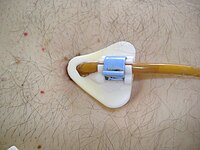
Photo from wikipedia
The endoscopic ultrasound-guided rendezvous technique (EUS-RV) is a salvage technique for failed biliary cannulation with benign disorders, but its success rate is not high [1–3]. The approach in a transduodenal,… Click to show full abstract
The endoscopic ultrasound-guided rendezvous technique (EUS-RV) is a salvage technique for failed biliary cannulation with benign disorders, but its success rate is not high [1–3]. The approach in a transduodenal, long endoscopic position (TDL) is preferred because it provides easier access to the bile duct, even if the bile duct is not dilated, as it stabilizes the scope position [4]. However, the TDL method, with a combination of a 19 G needle and 0.025-inch guidewire, directs the puncture needle toward the hepatic hilum because the range of motion of the scope and the needle is limited, making guidewire advance to the papilla challenging. Recently, a novel 0.018-inch guidewire (Fielder 18; Olympus, Tokyo, Japan) has been developed, which is similar to a 0.025-inch guidewire with good visibility, maneuverability, and stiffness (▶Fig. 1). Compared with the 19 G needle with 0.025-inch guidewire, a 22 G needle with the 0.018-inch guidewire has a more extensive range of motion for puncture, and the scope can be bent more acutely (▶Fig. 2, ▶Fig. 3). Therefore, the tip of the puncture needle can be directed toward the papilla, and the excellent maneuverability of this guidewire allows easier advance into the duodenum (▶Fig. 4). The 22 G needle may prevent bile leakage during the procedure due to its smaller diameter. A 74-year-old man underwent EUS-RV for common bile duct stones after failed biliary cannulation with endoscopic retrograde cholangiopancreatography. The extrahepatic bile duct was punctured during the TDL approach using a 22 G needle, with the 0.018-inch guidewire allowing easy advance into the duodenum. After passing through the papilla with the guidewire, biliary cannulation was achieved along the guidewire (▶Video 1). Finally, the stones were successfully removed without complications. Combining a 22 G needle and 0.018-inch guidewire may facilitate the EUS-RV technique and lead to a higher success rate of biliary cannulation. Endoscopy_UCTN_Code_TTT_1AS_2AD
Journal Title: Endoscopy
Year Published: 2023
Link to full text (if available)
Share on Social Media: Sign Up to like & get
recommendations!